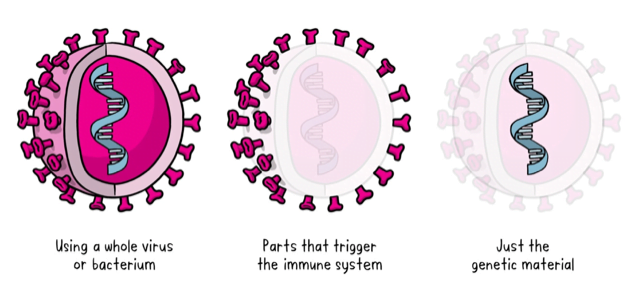UPSC Articles
SCIENCE & TECH/HEALTH
Topic:
- GS-3: General Science
Approaches to Vaccine Making
In News: The Centre is funding the development of four vaccines, which are currently in various stages of human trials
The four vaccines, being funded under Mission Covid Suraksha, were the
- DNA-based vaccine candidate by Cadila Healthcare, Gujarat
- Protein sub-unit vaccine by Biological E Ltd, Hyderabad
- Adenovirus intra-nasal vaccine by Bharat Biotech Ltd, Hyderabad
- m-RNA vaccine by Gennova Biopharmaceuticals, Pune.
There are three main approaches to making Vaccine

- The whole-microbe approach
- Inactivated vaccine: The first way to make a vaccine is to take the disease-carrying virus or bacterium, or one very similar to it, and inactivate or kill it using chemicals, heat or radiation Ex: Flu & polio vaccines. Also, Covaxin is an inactivated viral vaccine.
- A live-attenuated vaccine uses a living but weakened version of the virus or one that’s very similar Ex: measles, mumps and rubella (MMR) and the chickenpox vaccine.
Viral Vector Vaccine: This type of vaccine uses a safe virus (different from the one that caused disease) to deliver specific sub-parts – called proteins – of the germ of interest so that it can trigger an immune response without causing disease.
- Ex: COVISHIELD: A chimpanzee adenovirus – ChAdOx1 – has been modified to enable it to carry the COVID-19 spike protein into the cells of humans
- The subunit approach
- A subunit vaccine is one that only uses the very specific parts (the subunits) of a virus or bacterium that the immune system needs to recognize. It doesn’t contain the whole microbe or use a safe virus as a vector. The subunits may be proteins or sugars.
- Ex: whooping cough, tetanus, diphtheria and meningococcal meningitis.
- The genetic approach (nucleic acid vaccine)
- A nucleic acid vaccine just uses a section of genetic material that provides the instructions for specific proteins, not the whole microbe.
- DNA and RNA are the instructions our cells use to make proteins.
- In our cells, DNA is first turned into mRNA (messenger RNA), which is then used as the blueprint to make specific proteins.
- A nucleic acid vaccine delivers a specific set of instructions to our cells, either as DNA or mRNA, for them to make the specific protein that we want our immune system to recognize and respond to.
- This is a new way of developing vaccines.
- Before the COVID-19 pandemic, none had yet been through the full approvals process for use in humans, though some DNA vaccines, including for particular cancers, were undergoing human trials.














